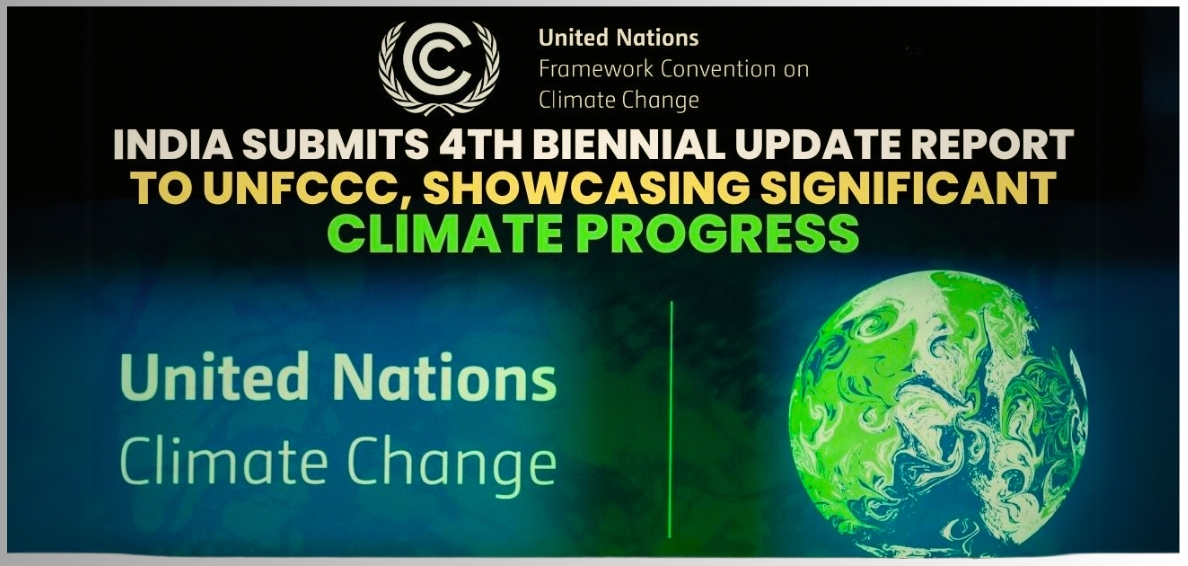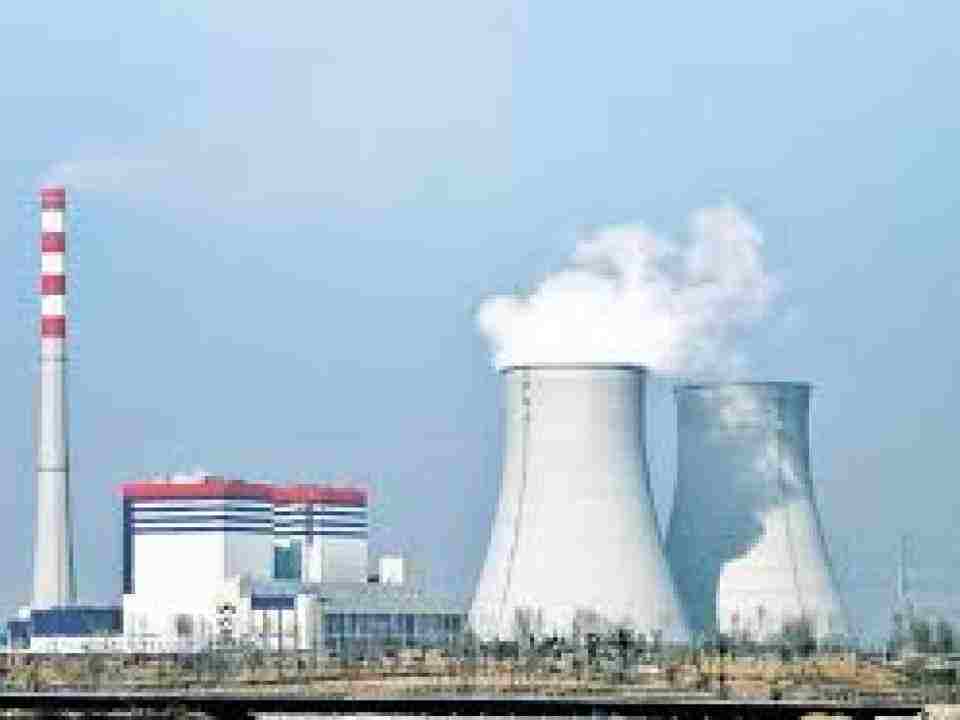- Courses
- GS Full Course 1 Year
- GS Full Course 2 Year
- GS Full Course 3 Year
- GS Full Course Till Selection
- MEP (Mains Enrichment Programme) Data, Facts
- Essay Target – 150+ Marks
- Online Program
- GS Recorded Course
- NCERT- First Ladder
- Polity
- Geography
- Economy
- Ancient, Medieval and Art & Culture AMAC
- Modern India, Post Independence & World History
- Environment
- Governance
- Science & Technology
- International Relations and Internal Security
- Disaster Management
- Ethics
- Current Affairs
- Indian Society and Social Issue
- CSAT
- 5 LAYERED ARJUNA Mentorship
- Public Administration Optional
- ABOUT US
- OUR TOPPERS
- TEST SERIES
- FREE STUDY MATERIAL
- VIDEOS
- CONTACT US
India’s 4th Biennial Update Report to the UNFCCC
India’s 4th Biennial Update Report to the UNFCCC
04-01-2025

- In December 2024, India has demonstrated its commitment to climate action and sustainable development by submitting its 4th Biennial Update Report (BUR-4) to the United Nations Framework Convention on Climate Change (UNFCCC).
- It provides detailed information about India’s greenhouse gas emissions for the year 2020, as well as insights into the nation’s mitigation efforts, progress on climate goals, and the challenges it faces in combating climate change.
- India, as one of the fastest-growing economies and home to nearly 1/6th of humanity, recognizes the importance of aligning its developmental aspirations with global sustainability goals.
- Through its proactive measures, the country continues to set an example of integrating economic growth with meaningful climate action.
Key Highlights of BUR-4
GHG Emissions in 2020
- India’s total GHG emissions in 2020, excluding Land Use, Land-Use Change, and Forestry (LULUCF), reached 2,959 million tonnes of CO2 equivalent.
- When accounting for LULUCF, the net emissions reduced to 2,437 million tonnes of CO2 equivalent.
-
Composition by Gas:
- Carbon dioxide accounted for 80.5% of emissions.
- Methane contributed 13.3%.
- Nitrous oxide made up 5.1%.
- Other gases accounted for 1%.
-
Emissions by Sector:
- Energy accounted for 75.6% of total emissions.
- Agriculture contributed 13.7%.
- Industrial Processes and Product Use (IPPU) made up 8.0%.
- Waste accounted for 2.5%.
- India’s forests and tree cover played a significant role in reducing emissions by sequestering approximately 522 million tonnes of CO2. This action effectively reduced the country’s total carbon dioxide emissions by 22%.
Progress Toward Nationally Determined Contributions (NDC)
India has made significant strides in meeting its NDC targets, reflecting its commitment to decouple economic growth from GHG emissions.
- Reduction in Emission Intensity:
- India has reduced the emission intensity of its Gross Domestic Product (GDP) by 36% between 2005 and 2020, reflecting its success in decoupling economic growth from GHG emissions.
- Expansion of Renewable Energy Capacity:
- By October 2024, non-fossil sources accounted for 46.5% of India’s total installed electricity generation capacity.
- India’s renewable energy capacity, including large hydropower, reached 203 GW.
- The capacity for renewable energy, excluding large hydro, increased from 35 GW in 2014 to 156 GW in 2024.
- Growth in Specific Renewable Sources:
- Solar energy capacity grew 35 times, from 2.6 GW in 2014 to 92 GW in 2024.
- Wind energy capacity more than doubled, increasing from 21 GW in 2014 to 48 GW in 2024.
- Increase in Forest and Tree Cover:
- Forest and tree cover now account for 25% of India’s geographical area.
- Between 2005 and 2021, India created an additional carbon sink of 2.3 billion tonnes of CO2 equivalent.
What Are NDCs?
Key Features:
India’s NDCs:
|
India’s Approach to Climate Change
- Comprehensive Approach: India follows a comprehensive approach to address climate change, which balances its developmental aspirations with its environmental commitments.
- The country adheres to the principles of equity and common but differentiated responsibilities and respective capabilities (CBDR-RC), as outlined in the UNFCCC and the Paris Agreement.
- Development Along Low-Carbon Pathways: India remains committed to achieving net-zero emissions by 2070.
- The government ensures that economic growth proceeds along low-carbon pathways to meet its sustainability goals.
- Proactive Global Engagement: India recognizes that climate change is a global challenge requiring collective action.
- The country actively advocates for multilateral cooperation to secure financial, technological, and capacity-building support for climate initiatives.
- Leadership in Sustainable Growth: India’s Union Minister for Environment, Forest, and Climate Change highlighted the country’s leadership in aligning economic growth with environmental responsibility.
Sectoral Mitigation Efforts
- Energy Sector: Share of renewable sources in total electricity generation increased significantly.
- Programs like UJALA and the Street Lighting National Programme have contributed to substantial energy savings and avoided emissions.
- Transport Sector: Initiatives like FAME-II and Ethanol Blended Petrol Program promote cleaner transportation.
- Electrification of railways and development of metro rail systems are reducing carbon footprints.
- Agriculture: Implementation of practices like Direct-Seeded Rice and System of Rice Intensification has reduced emissions.
- Neem-coated urea has significantly improved nitrogen use efficiency, avoiding 27 MtCO2 emissions from 2019 to 2024.
- Forestry and Land Use: Programs such as the Green India Mission and Nagar Van Yojana have enhanced carbon sequestration and biodiversity conservation.
- Waste Management: Initiatives under the Swachh Bharat Mission and National Bioenergy Program have improved solid waste management and promoted waste-to-energy projects.
What is The United Nations Framework Convention on Climate Change (UNFCCC)?
Key Mechanisms of the UNFCCC:
Principles:
|
Challenges and Future Directions
- India faces several challenges in its climate action efforts, including the need for increased financial resources, advanced technologies, and capacity-building support.
- Despite these challenges, India has demonstrated its commitment to combating climate change while ensuring economic development.
- The BUR-4 emphasizes the importance of continuous global cooperation and equitable support to help countries like India achieve their climate goals.
- India’s progress showcases how developing nations can integrate sustainable growth with proactive climate strategies.
Conclusion
India’s Fourth Biennial Update Report reaffirms its dedication to addressing climate change through effective policies and sustainable practices. The nation’s achievements, including significant reductions in emission intensity, expansion of renewable energy capacity, and growth in forest cover, underline its leadership in global climate action. India continues to set an example by balancing economic progress with environmental responsibility, providing a roadmap for sustainable development in the years ahead.
|
Also Read |
|



